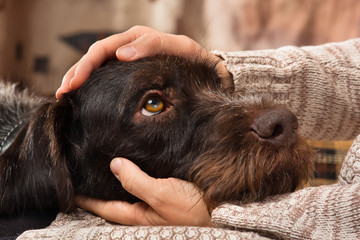
What Happens to Your Brain When You Pet Dogs?
What is it about dogs that give people warm, fuzzy feelings when we pet them? A new study sheds light on what happens to the brain when people touch dogs.
For the study, published Wednesday in PLOS (Public Library of Science) ONE, a team of researchers looked at the changes in brain activity when people come in contact with a dog.
"Although the effects of contact with animals on human mental and physical health have received increasing attention, the neurophysiological correlates of these effects are not yet fully understood," the researchers wrote. "These correlates are, however, highly relevant to understanding the mechanisms underlying human–animal relationship and to designing effective animal-assisted interventions."
The team conducted an experiment involving 19 participants, who interacted with dogs that were trained to work in a hospital setting. The dogs were of Jack Russel Terrier, Goldendoodle and Golden Retriever breeds.
The participants engaged in multiple sessions: Three with a real dog and three others with a plush animal. In these sessions, the participants first viewed the dog or plush toy from a distance (watching), then reclined with animal but were not allowed to pet them (feeling), and finally, they were allowed to pet them (petting).
The prefrontal cortex activity was measured using a non-invasive neuroimaging technology. They also checked oxygen saturation percent in the prefrontal cortex and heart rates.
"Prefrontal brain activation in healthy subjects increased with the rise in interaction closeness with a dog or a plush animal," the researchers wrote. "Moreover, interaction with a dog stimulated more brain activity compared to the control condition, suggesting that interactions with a dog can activate stronger attentional processes and elicit more emotional arousal than interacting with a nonliving stimulus."
In other words, the prefrontal cortex activity increased each time the participants interacted with the subjects (dog or plush) with increased closeness. However, contact with the real dogs prompted greater activity.
The difference was the largest when it came to petting. The effects persisted even after the dogs had left. However, they were reduced when the animals were replaced with a stuffed animal.
"This indicates that interactions with a dog might activate more attentional processes and elicit stronger emotional arousal than comparable nonliving stimuli," the researchers wrote.
The prefrontal cortex isn't just involved in functions such as working memory, problem solving and attention, "but also with social and emotional processes." And for many people, interacting with animals is "highly emotionally relevant," so it makes sense that it has elicited such a higher response than the plush animal.
While there may be several explanations, the results of the study could have implications for animal-assisted therapy.
For instance, the researchers noted that a patient with social and attention deficits who displays "emotional involvement" with dog-related activities could benefit from such an intervention, as the results of the study imply that physical contact with a familiar dog may "promote social attention in humans."
"Integrating animals into therapeutic interventions might therefore be a promising approach for improving emotional involvement and attention," the researchers wrote.
For the study, published Wednesday in PLOS (Public Library of Science) ONE, a team of researchers looked at the changes in brain activity when people come in contact with a dog.
"Although the effects of contact with animals on human mental and physical health have received increasing attention, the neurophysiological correlates of these effects are not yet fully understood," the researchers wrote. "These correlates are, however, highly relevant to understanding the mechanisms underlying human–animal relationship and to designing effective animal-assisted interventions."
The team conducted an experiment involving 19 participants, who interacted with dogs that were trained to work in a hospital setting. The dogs were of Jack Russel Terrier, Goldendoodle and Golden Retriever breeds.
The participants engaged in multiple sessions: Three with a real dog and three others with a plush animal. In these sessions, the participants first viewed the dog or plush toy from a distance (watching), then reclined with animal but were not allowed to pet them (feeling), and finally, they were allowed to pet them (petting).
The prefrontal cortex activity was measured using a non-invasive neuroimaging technology. They also checked oxygen saturation percent in the prefrontal cortex and heart rates.
"Prefrontal brain activation in healthy subjects increased with the rise in interaction closeness with a dog or a plush animal," the researchers wrote. "Moreover, interaction with a dog stimulated more brain activity compared to the control condition, suggesting that interactions with a dog can activate stronger attentional processes and elicit more emotional arousal than interacting with a nonliving stimulus."
In other words, the prefrontal cortex activity increased each time the participants interacted with the subjects (dog or plush) with increased closeness. However, contact with the real dogs prompted greater activity.
The difference was the largest when it came to petting. The effects persisted even after the dogs had left. However, they were reduced when the animals were replaced with a stuffed animal.
"This indicates that interactions with a dog might activate more attentional processes and elicit stronger emotional arousal than comparable nonliving stimuli," the researchers wrote.
The prefrontal cortex isn't just involved in functions such as working memory, problem solving and attention, "but also with social and emotional processes." And for many people, interacting with animals is "highly emotionally relevant," so it makes sense that it has elicited such a higher response than the plush animal.
While there may be several explanations, the results of the study could have implications for animal-assisted therapy.
For instance, the researchers noted that a patient with social and attention deficits who displays "emotional involvement" with dog-related activities could benefit from such an intervention, as the results of the study imply that physical contact with a familiar dog may "promote social attention in humans."
"Integrating animals into therapeutic interventions might therefore be a promising approach for improving emotional involvement and attention," the researchers wrote.
—------------------------------------------------------------------------------------------------
If you would like to learn more about mindfulness and mental health, check out the following courses:
- Improving Mental and Behavioral Health Care with Digital Technology
- Mindfulness in Nursing: Decreasing Burnout, Improving Outcomes
- Self-Care for Nurses
Our courses are available for purchase by the individual or facility. For individuals, register with us to create your username and password, click on the course title of interest and then click the Buy Now button. For a complete listing of all our online continuing education courses click here.
For facilities or organizations that would like to purchase education for their staff, email sales@pedagogyeducation.com let us know the course(s) of interest and how many staff members you need to provide education for, and we will be happy to send you a price quote!

